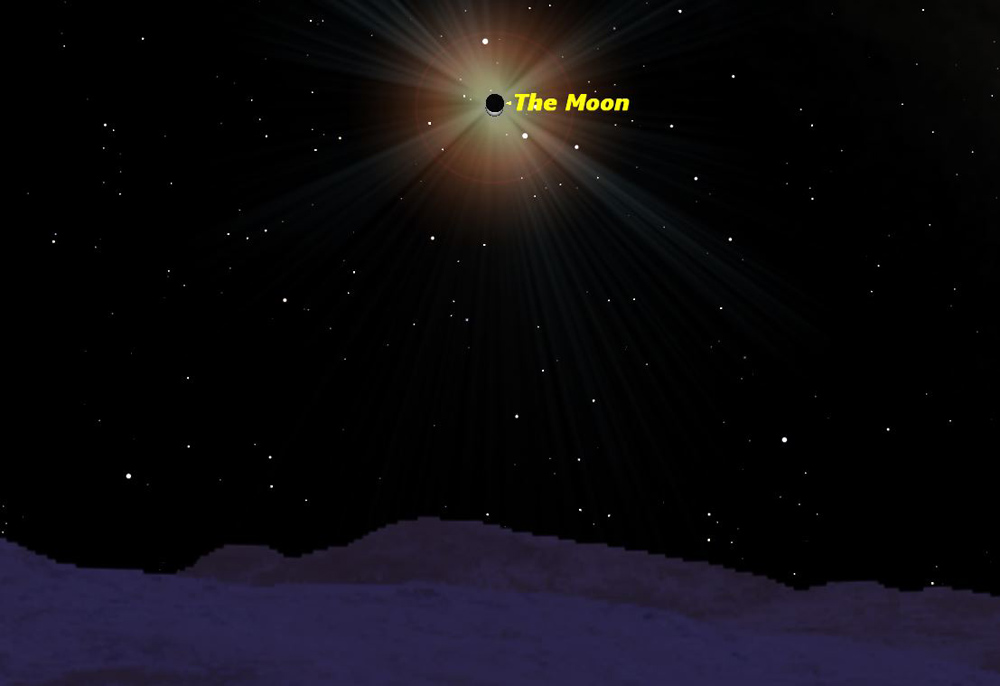
This Friday (Nov. 25), a rather large partial eclipse of the sun will be on view — but only for a relatively small audience.
This will be the fourth time that a new moon will orbit between the sun and Earth to cause a solar eclipse in 2011, just one eclipse shy of the maximum for the number of solar eclipses in a given year.
The first eclipse on Jan. 4 coincided with sunrise across Europe.
Some Alaskans and Canadians shared a view of a partially obscured sun on the afternoon of June 1. [Photos: The First Solar Eclipse of 2011]
And perhaps just a few penguins experienced a very slight eclipse a month later off Lutzlow-Holm Bay on the coast of Antarctica.
On Friday, the moon's penumbral, or outer, shadow will brush the southern belly of the Earth, initially touching down in the South Atlantic Ocean, about 600 miles (1,000 kilometers) a southwest of Cape Town, but only managing to encompass the southern and western portion of South Africa, completely missing Lesotho and barely grazing the border of Namibia. The sun will be seen rising with a dent in its upper right rim.
The axis of the Earth's shadow, containing the cone of darkness known as the umbra, from where we could see a total solar eclipse, misses Earth entirely, passing at its nearest, only about 0.05 of the Earth's radius, or about 210 miles (340 km) out in space.
Get the Space.com Newsletter
Breaking space news, the latest updates on rocket launches, skywatching events and more!
So the depth of this partial eclipse is greater than the three others that preceded it. At greatest eclipse, 90.5 percent of the sun's diameter will be covered as seen from the place nearest to the shadow axis, at a point in the Bellingshausen Sea along the west side of the Antarctic Peninsula.
Here, the sun will be seen to dip to the southern horizon at the "midnight" of its 24-hour southern late spring day, and as it slowly ascends still very low to the south-southeast horizon it turns into a delicate boat-shaped crescent in eclipse; the horizon along which the dazzling boat goes rocking is that of "The Ice" (a nickname for Antarctica, being "on the ice").
As the penumbra slides under the bottom of the Earth, the partial eclipse is visible in varying extent across the icy land continent and just as it begins to slide back out into space it (just barely) manages to pass over Tasmania as well as portions of New Zealand's South Island. In fact, the last contact of the shadow with Earth occurs just to the west of the South Island, in the Tasman Sea.

Coming attractions
If you have already obtained a calendar for 2012, be sure to put a big red circle around May 20.
That is the date of the next solar eclipse and it promises to be a spectacular event. It will be an annular ("ring") eclipse that will be visible from parts of eight western U.S. states during the late-afternoon hours.
For those living in parts of New Mexico and west Texas, the setting sun will be transformed into a blazing "ring of fire," in some cases lasting for more than five minutes. And across much of North America, the exception being those near and along the Atlantic Coast, the sun will appear partially eclipsed.
Across the Pacific for parts of China and Japan, the annular eclipse will also be visible (Tokyo is directly in the eclipse track), although for Asia, being positioned to the left (west) of the International Date Line, this event will take place on the morning of May 21.
Needless to say, in contrast to next Friday, next May's solar eclipse will have a huge viewing audience.
Editor's note: If you snap a photo or video of the eclipse and want to share it with SPACE.com for a story or gallery, please email Clara Moskowitz at cmoskowitz@space.com and Denise Chow at dchow@space.com.
Joe Rao serves as an instructor and guest lecturer at New York's Hayden Planetarium. He writes about astronomy for The New York Times and other publications, and he is also an on-camera meteorologist for News 12 Westchester, N.Y.
Join our Space Forums to keep talking space on the latest missions, night sky and more! And if you have a news tip, correction or comment, let us know at: community@space.com.

Joe Rao is Space.com's skywatching columnist, as well as a veteran meteorologist and eclipse chaser who also serves as an instructor and guest lecturer at New York's Hayden Planetarium. He writes about astronomy for Natural History magazine, Sky & Telescope and other publications. Joe is an 8-time Emmy-nominated meteorologist who served the Putnam Valley region of New York for over 21 years. You can find him on Twitter and YouTube tracking lunar and solar eclipses, meteor showers and more. To find out Joe's latest project, visit him on Twitter.









